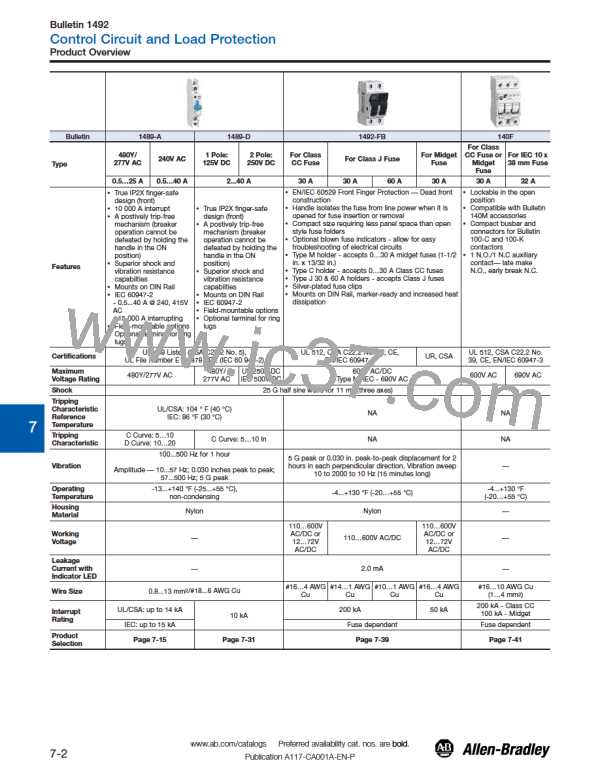Bulletin 1489-A
Circuit Breaker
Product Description
Circuit Breaker Application Information
Application Considerations
Selection of a Bulletin 1489 circuit breaker with appropriate circuit
protection includes consideration of:
The following is a discussion of application considerations related to
North American applications. When applying product to IEC
regional requirements, follow IEC practices and guidelines.
0
1
ꢀ Circuit voltage
The selection of a specific ampere rating for a specific application is
dependent on the type of load and duty cycle and is governed by
the National Electric Code (Canadian Electric Code) and UL/CSA. In
general, the codes require that overcurrent protection is at the
current supply and at points where wire sizes are reduced. In
addition, the codes state that conductors be protected according to
their current carrying capacity. There are specific situations that
require application consideration, such as motor circuit, and
guidelines for the selection for transformer protection.
ꢀ Circuit frequency
ꢀ Available short circuit current
ꢀ Continuous current rating
ꢀ Application considerations
ꢀ Special operating conditions
The following discussion is based upon National Electric Code and
UL requirements. Similar considerations are appropriate for
Canadian applications.
2
The Bulletin 1489-A circuit breakers are “non 100 percent rated” as
defined by UL 489, para 7.1.4.2. As such, the circuit breaker's
rating should be loaded to no more than 80% if used with
continuous loads.
Circuit Voltage
The Bulletin 1489-A circuit breakers are rated by voltage class.
Applications should not exceed the listed voltage and current range
(see Table 1).
3
Line and load may be reversed. The Bulletin 1489 circuit breaker
may be bottom fed.
Branch Circuits:
Circuit Frequency
Bulletin 1489-A circuit breakers may be used to protect branch
circuits. A branch circuit is the wiring portion of a system extending
beyond the final overcurrent device protecting the circuit.
The Bulletin 1489-A circuit breakers may be applied to frequencies
of 50 Hz and 60 Hz without derating. For applications above 60 Hz,
contact Rockwell Automation with specific application information
for the derating of the circuit breakers.
4
Guidelines established in NEC, CEC, UL, and CSA should be used
to determine the specific device. For example:
Available Short Circuit Current
1) Motor Branch Circuit
The Bulletin 1489-A circuit breakers should only be applied in those
applications in which the available short-circuit (or fault) current is
less than or equal to 10 kA...14 kA (US/Canada) and 15 kA (IEC).
5
Bulletin 1489-A circuit breakers are not horsepower rated because
they are able to safely interrupt currents far in excess of the locked
rotor value for a selected motor. This ability is recognized in the
codes and standards and is also established by the UL and CSA
tests described in UL 489 and CSA C22.2 No. 5 standards.
Table 1. Voltage and Current Ranges
Region
Max. Voltage
415V AC
Current Range [A]
0.5...40
6
The size of a Bulletin 1489 circuit breaker should be determined
following the guidelines for an Inverse Time Circuit Breaker.
EN/IEC Regions
48V DC
0.5...40
References: NEC 430.51 and UL 489. Also see CEC and appropriate
Canadian Standards.
240V AC
0.5...40
480Y/277V AC
1-pole 48V DC
2-pole 96V DC
0.5...32
North America (UL 489
& CSA C22.2 No. 5)
7
2) Transformer Protection
0.5...40
0.5...40
Bulletin 1489-A circuit breakers may be used for transformer
protection following the guidelines established.
Continuous Current Rating
Standard current ratings are: 0.5, 1, 1.5, 2, 3, 4, 5, 6, 7, 8, 10, 15,
16, 20, 25, 30, 32, 35, and 40 A.
References: NEC 450 and UL 489. Also see CEC and appropriate
Canadian Standards.
8
3) Heater Load, Lighting, and Other Load Protection
The Bulletin 1489-A circuit breakers are rated in RMS amperes at a
40 °C (104 °F) ambient temperature per the UL 489 (CSA 22.2 No.
5) standard. This temperature is generally used as the average
temperature within an industrial enclosure. If a circuit breaker is
applied in a temperature that exceeds the 40 °C (104 °F) ambient,
then the circuit breaker should be derated. For IEC 60 947-2
standard, the products carry an ambient rating of 30 °C. Follow
standard IEC application considerations for temperature rating in
different ambient temperatures.
Bulletin 1489-A circuit breakers may be used for protection of
heater loads, lighting loads, and other loads following the guidelines
established.
9
References: NEC Article 31 and UL 508A. Also see CEC and
appropriate Canadian Standards.
Coordinated Overcurrent Protection
Where an orderly shutdown is required to minimize the hazards to
personnel and equipment, a system of coordination based upon the
faulted or overloaded circuit is isolated by selective operation of
only the overcurrent protective device closest to the overcurrent
condition. The user should select devices that meet this
requirement.
10
11
12
13
The characteristic trip curves are shown on page 7-19. The trip
bands shown for each breaker represent current tripping limits for a
circuit breaker and are within the limits established by UL. For a
specific current at 40 °C (104 °F), a circuit breaker will open ("clear
the circuit") automatically at some total time that will be within the
"Minimum" and "Maximum" time shown on the curves. For
example, page 7-19 shows that a one-pole, 15 A, Bulletin 1489-A
circuit breaker trips in not less than 10 s and not more than 120 s
on a 30 A current. Because the UL standard defines this time
spread, users should not specify exact tripping time. The lower
current portion of the curves (upper left) depict the time to trip due
to thermal action and reflect overload protection of the wire and
connect load. The higher current portion of the curves (lower right)
depicts the trip due to magnetic action of the circuit breaker and
reflects protection due to short circuit level currents.
References: NEC 240.12. Also see CEC.
www.ab.com/catalogs
Preferred availability cat. nos. are bold.
7-16
Publication A117-CA001A-EN-P

 ROCKWELL [ ROCKWELL INTERNATIONAL CORPORATION. ]
ROCKWELL [ ROCKWELL INTERNATIONAL CORPORATION. ]